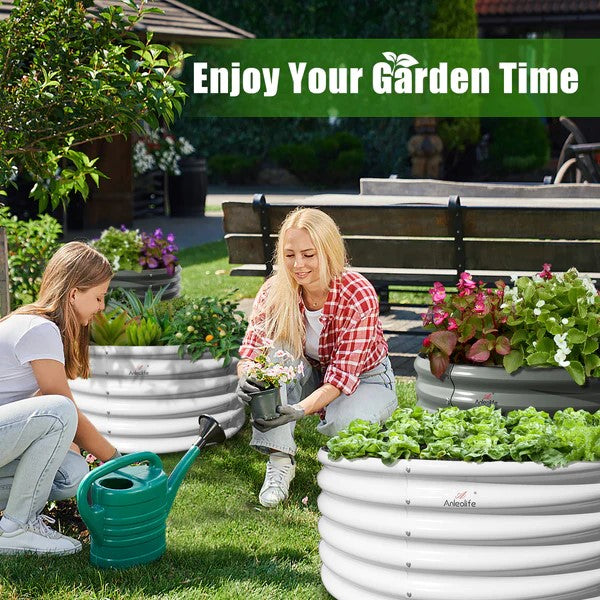Metal raised garden beds undoubtedly improve the aesthetics of any backyard space. Their drainage is relatively simple to achieve, and it extends the growing season and yield of anything you choose to plant. Container planting always requires adequate drainage. Without it, the soil becomes waterlogged, and the root system suffers. Proper drainage is crucial for the success of your metal raised bed. And while raised beds generally drain better than inground gardens, there’s always room for improvement.
Poor Drainage That Causes Raised Beds So Wet
A drainage system will help to remove water from the area where you put your raised beds. There could be several reasons why your raised garden bed is too wet. These can be:
- Soil composition – your soil is too heavy, dense, or clay-like for your raised bed. Instead of draining, water sits and pools.
- Insufficient or blocked drainage holes – raised beds with solid bottoms need adequate drainage holes to release excess water. So in this case bottomless metal raised garden bed can be a better choice.
- Compact soil or lack of aeration – there isn’t enough air circulating through your soil. More air means drier soil.
- Slope or leveling issues – your raised bed slopes so water pools at the low end. Or, it’s sitting at the bottom of a slope that accumulates water runoff.
- Weather coupled with overwatering – you’re experiencing excessive rain, or you overwatered your raised bed, or both.
Choose a Good Site for Your Metal Raised Bed
The first step is to choose a good site for your metal raised garden bed. When choosing the ideal site for your raised bed, you will want to look at a few things:
- the type of soil that will be under the raised bed
- the amount of sunlight exposure in that area
- the drainage pattern in the yard
Dig into the yard in a few places and see what type of soil you have. If it is sandy, it may drain well without any additional work. If it is heavy clay, it will hold moisture and will not drain as quickly.
Choose a spot where the soil is sandy and loose, which will allow it to drain better. Remember: for the water to drain out of the bottom of the raised bed, it has to go into the soil below!
Also, wait for a sunny day and see where the shady spots are in the yard. You will want to avoid those shady spots. Remember: trees that are bare in the winter will block out lots of sunlight when their leaves come out in the spring. Think ahead before choosing a site for your raised bed – keep it away from trees that will provide too much shade!
Finally, take a look at your yard after a heavy rainstorm. Are there any areas where water is pooling up? If so, avoid those places for your raised bed!
If water is pooling up all over the yard after a storm, you might need to install a drainage system before you put in your raised bed.
Install a Drainage System for Your Raised Bed
A drainage system will help to remove water from the area where you put your raised bed. There are two basic options: drainage pipes (above or below ground), or foundation material that drains well.
If you choose drainage pipes, don’t send the water towards your house, or towards a neighbor’s house. Also, call before you dig to find out if there are any buried gas lines in your yard.
When choosing a material for the foundation below your raised bed, you will want something that drains well. Remember that clay soil drains poorly, while sand drains well. You can also use gravel as a medium to let water drain out of your raised bed faster.
Choose the Right Elevation for Your Raised Bed
A taller raised bed has more capacity to hold water from a rainstorm. This means that your plants are less likely to suffer from over watering after summer rainstorms. A taller raised bed is also more forgiving for beginner gardeners, who are prone to overwatering plants.
The only downside of a taller raised bed is that it will be difficult to access, especially if it is built for someone who is disabled. One way around this problem is to build a raised platform around the raised bed (almost like steps) to make it easier to access the bed.
Use a Raised Bed Liner that Allows Drainage
Now that you have the right location and the right elevation for your raised bed, you may want to install a raised bed liner. There are some good reasons for doing so.
A good raised bed liner will allow water to drain away, without allowing soil to drain away. You can use landscape fabric, canvas, or hardware cloth (metal mesh) to line your raised bed while also allowing drainage.
Don’t use a plastic liner that is non-permeable. Otherwise, the water not drain, and your plants will suffer the consequences!
In conclusion, drainage for metal raised garden beds is essential for ensuring healthy plant growth and preventing soil erosion. By following these simple steps, you can create a well-designed system that will provide your plants with the necessary nutrients and water they need to thrive.




